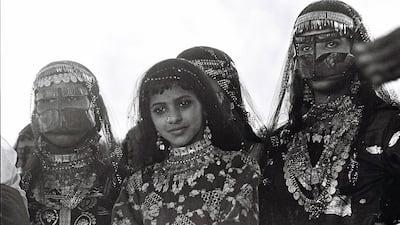Umm Abdullah from Abu Dhabi still remembers the beautiful traditional kandura she wore for her wedding in the 1970s. Looking stunning in her Murta’esha, a wide necklace with hanging geometric design, all eyes were on her. She sighs fondly at the memory.
Now in her 50s, she is still a woman of style. Today she is wearing a yellow and blue kandura whose embroidery matches the colours and design. With a precious gem-studded ring and necklace, she is living proof that being fashionable has nothing to do with age.
Covering her face is a burqa. To Umm Abdullah, this is an important part of her accessories, worn every day to adorn her further.
Unlike the Afghan burqa, a garment which covers a woman from head-to-toe, the Gulf burqa, one the oldest items of dress in the region, only partially covers a women’s forehead and upper lip in a horizontal “H” shape. These days, though, the wearing of a burqa is a dying practice, usually found among the older generation. Among younger women, the burqa is used for decoration and not necessarily for daily wear. At a distance, to the untrained eye, the burqa might appear to be made of gold or another metal, but “it’s from cloth imported from India”, says Umm Abdullah. Traditionally a red burqa, also known as “nili,” was the most predominant colour. While a burqa can serve a different purpose for different women, for Umm Abdullah a “burqa was part of our daily wear”.
She started wearing her burqa right after her engagement at the age of 14. In those days, girls usually put on a burqa after their engagement or when they hit puberty.
The design of a burqa changes depending on which part of the UAE its owner is from. The Dubai design, the “Zabeel cut”, also worn in Abu Dhabi, has a narrow top and broad, curved bottom. The Al Ain design features both a narrow top and bottom. In Sharjah, the burqa resembles the Zabeel cut but is shaped so the top of the mask is inclined forwards.
The Bahraini and Qatari burqa is square, while in Oman, and also in Fujairah, it is very large; broader at the top with a tip that goes beyond the forehead. In Saudi Arabia, the niqab – the black veil covering the face, leaving the eyes open – is worn instead.
“When I got engaged, I wore a long burqa in public, leaving only the eyes visible,” Umm Abdullah recalls.
It was believed that the burqa protected a women’s face from the scorching sun and dust. There are also tales that the design of the burqa echoed the features of the falcon, a symbol of pride, strength and grace.
Like most women, Umm Abdullah married one of her cousins. Once she was married, her long, fuller burqa was replaced with a shorter one. Like any good wife, she would adorn herself for her husband when he was home. When he went away on business, she would go back to wearing the long burqa.
“I would keep the long burqa till he returns from the trip, so that when he comes back, he finds my face glowing and shiny,” she says. She also felt shy wearing the short burqa in the absence of her husband.
There are many reasons why women chose to wear the burqa. After pausing to fix her own burqa, Umm Abdullah explains some of them.
“In the golden days, whenever a woman wore a burqa, it immediately meant that she was ‘taken’,” she says. In those days, a girl would not attend a wedding or even step out of her house without a legitimate reason. It was considered immodest for a girl to sit in a women’s gathering because too often, women disclosed many secrets, so it was best for a teenager to stay away from such gatherings.
“Before and after marriage, I lived a good life. I thank Allah for that,” says Umm Abdullah.
aalhameli@thenational.ae

